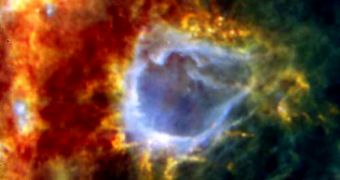Scientists at the ETH Zürich in Switzerland have recently determined the existence of a new phase of water in a star-forming region of the Milky Way. The researchers there say that the vapors their analysis revealed have electrical charges, something that has not been observed in nature back on Earth. Generally, the stuff is considered as being without smell, taste or charge, but that does not appear to always be the case in space, the experts explained on Thursday.
Speaking at a conference that the European Space Agency (ESA) held in Noordwijk, The Netherlands, the investigators added that electrically-charged water would most likely never occur by natural causes on our planet. Three states are indigenous to our world, they explained, and namely gaseous Steam, solid ice and liquid. Getting the stuff to take on other phases is a laborious, intensely-artificial process, which requires catalysts that cannot possibly exist in the correct combination in nature.
The group said that the recent study was conducted using the ESA Herschel Space Observatory, which was launched last year aboard an Ariane V delivery system. This is the largest and most orbit-based telescope ever launched, and it is currently located in the L2 Lagrangian point. This is a spot in the Sun-Moon-Earth system where the telescope always maintains the same relative position in respect to these three bodies. This allows its sunshield to protect its sensitive instruments from stray light, thus increasing its observing power considerably. There are a total of five Lagrangian points that can be used for this kind of orbital configuration. Herschel is located some 1.5 million kilometers away from Earth, Space reports.
“This detection of ionized water vapor came as a surprise. It tells us that there are violent processes taking place during the early birth stages which lead to widespread energetic radiation throughout the cloud,” told attendants ETH Zürich expert Arnold Ben. He explained that the electric charge occurs when a single electron is knocked out of a water molecule. This happens as new stars form, triggering the release of impressive amounts of ultraviolet (UV) radiation. These energetic photons travel at considerable speeds through the cocoons of dust and gas surrounding new stars, wreaking havoc in all water molecules they encounter. Herschel's instruments are sensitive enough to detect these changes.

 14 DAY TRIAL //
14 DAY TRIAL //